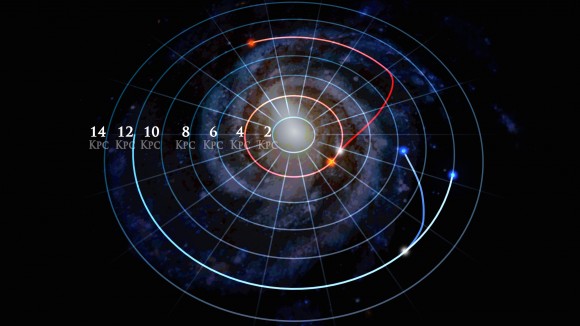
A team of scientists from the Sloan Digital Sky Survey (SDSS) has created a new map of the Milky Way that shows nearly a third of the stars have dramatically changed their obits. Their study is published in the July 29 issue of The Astrophysical Journal.
Michael Hayden, an astronomy graduate student at New Mexico State University, is lead author of the study. Hayden said:
In our modern world, many people move far away from their birthplaces, sometimes halfway around the world. Now we’re finding the same is true of stars in our galaxy – about 30 percent of the stars in our galaxy have traveled a long way from where they were born.
To build the new map of the Milky Way, scientists used a spectrograph on the SDSS Apache Point Observatory in New Mexico to observe 100,000 stars during a 4-year period.
The key to creating and interpreting this map of the galaxy is measuring the elements in the atmosphere of each star. Hayden said:
From the chemical composition of a star, we can learn its ancestry and life history.
The chemical information comes from spectra, which are detailed measurements of how much light the star gives off at different wavelengths. Spectra show prominent lines that correspond to elements and compounds. Astronomers can tell what a star is made of by reading these spectral lines.
The team mapped the relative amounts of 15 separate elements, including carbon, silicon, and iron for stars all over the galaxy. What they found surprised them – up to 30 percent of stars had compositions indicating that they were formed in parts of the galaxy far from their current positions.
When the team looked at the pattern of element abundances in detail, they found that much of the data could be explained by a model in which stars migrate radially, moving closer or farther from the galactic center with time.
These random in-and-out motions are referred to as “migration,” and are likely caused by irregularities in the galactic disk, such as the Milky Way’s famous spiral arms. Evidence of stellar migration had previously been seen in stars near the sun, but the new study is the first clear evidence that migration occurs throughout the galaxy.
Enjoying EarthSky? Sign up for our free daily newsletter today!
Bottom line: Scientists from the Sloan Digital Sky Survey (SDSS) have created a new map of the Milky Way that shows nearly a third of the stars in have dramatically changed their obits. Their study is published in the July 29 issue of The Astrophysical Journal.











